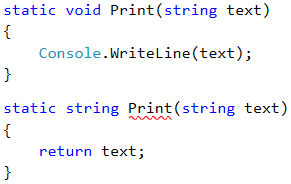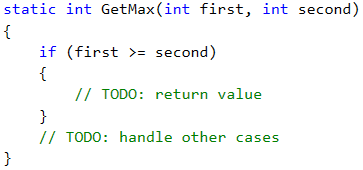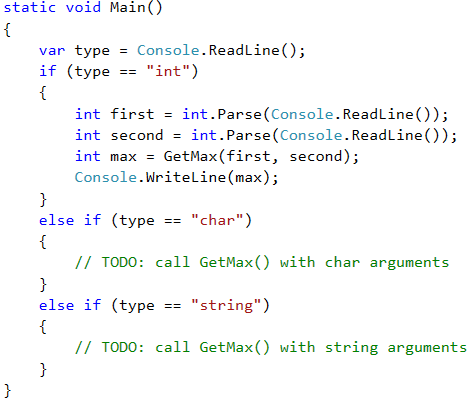Method Overloading
In many programming languages like C# and Java the same method can be declared in few variants with the same name and different parameters. This goes by the term “method overloading”. Now let's see how to write these overloaded methods in C#.
Method Signature
In programming methods are identified through the elements of their declaration: name of the method + a list of its parameters. These two elements define its specification, the so called “method signature”.
The method signature is defined by the method name and the definitions of the method parameters (only parameter types are considered, and the parameter names are ignored). Example:

In this example the method's signature is its name (Print), together with its parameter types (string).
If our program holds several methods with the same name, but with different lists of parameters (signatures), we can say that we use method overloading.
Overloading Methods in C# Programs
As we mentioned, if you use the same name for several methods with different signatures, this means that you are overloading a method. The code below shows how three different methods can use the same name, but have different signatures and execute different actions.

Signature and Return Value Type
It is important to say that the returned type as a result of the method is not a part of its signature. If the returned type was a part of the signature, then the compiler doesn't know which method exactly to call (there is an ambiguity).
Let's look at the following example: we have two methods with different return types. Despite that, Visual Studio shows that there is a mistake, because both of their signatures are the same. Therefore, when trying to call a method named Print(…), the compiler can't know which of the two methods to invoke.

Example: Greater of Two Values
The input is two values of the same type. The values can be of int, char or string type. Create a method GetMax() that returns as a result the greater of the two values.
Sample Input and Output
| Input | Output | Input | Output | Input | Output |
|---|---|---|---|---|---|
| int 2 16 |
16 | char a z |
z | string Ivan Tod |
Tod |
Creating the Methods
We need to create three methods with the same name and different signatures. First we create a method, which will compare integers.

Following the logic of the previous method we create another one with the same name, but this one will compare characters.

The next method we need to create will compare strings. The logic here is a bit different from the previous two methods because variables of string type cannot be compared with the operators < and >. We will use the method CompareTo(…), which returns a numerical value: larger than 0 (the compared object is larger), smaller than 0 (the compared object is smaller) and 0 (the two objects are the same).

Reading the Input Data and Using the Methods
The last step is to read the input data, to use the appropriate variables and to invoke the method GetMax() from the body of the Main() method.

Testing in the Judge System
Test your solution here: https://judge.softuni.org/Contests/Practice/Index/594#6.